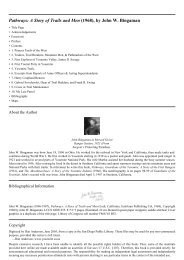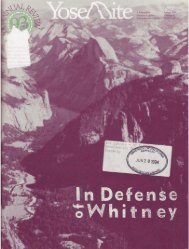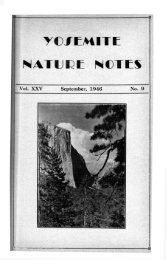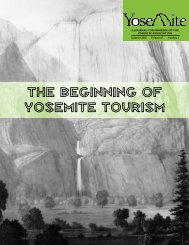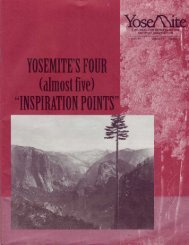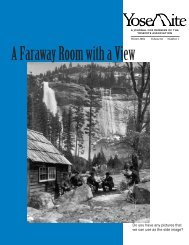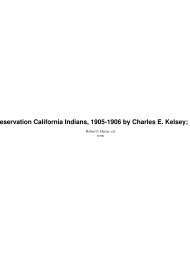Create successful ePaper yourself
Turn your PDF publications into a flip-book with our unique Google optimized e-Paper software.
!iWho Was John Muir?by Hugh MaguireAs residents and employees in <strong>Yosemite</strong> National Park, wefrequently come across the name John Muir. Yet many of usconcluded that glaciers had formed and carved <strong>Yosemite</strong> to itspresent-day shape. Over the next few years Muir embarked on aknow little about the man. Who was he? Why is he associated number of daring solo journeys throughout <strong>Yosemite</strong> to studywith <strong>Yosemite</strong>?John Muir was born in Dunbar, Scotland, in 1838, the thirdchild in eight. His father, Daniel, owned a food and grain storebut aspired to be an evangelist, and his mother, Ann, was aquiet, artistic woman who loved nature. In 1849 the Muirs emigratedto Americ and settled in southern Wisconsin.At 22 years of age, John left home to enter the University ofWisconsin in Madison but after just two and a half years ofstudying Latin, Greek, chemistry and geology, he left formalschooling for the classrooms of natu re. Traveling to Canada, hefelt "free as a bird, independent alike of roads and people" andevidence of glacial action. He told everyone he knew about histheories and thus became heavily involved in a controversy.Josiah Whitney, professor of geology at Harvard University andstate geologist of California, had pronounced that the <strong>Yosemite</strong>was created by a giant cataclysm. Upon hearing of Muir’s glacialtheory, Whitney ridiculed Muir, calling him "a mere sheepherder,an ignoramous." Muir, undaunted, believed physical fact assacred as moral principle and stuck to his beliefs. With theencouragement of friends he wrote an article entitled "TheDeath of a Glacier" and sent it off to the New York Tribunenewspaper. To his astonishment it was accepted, published and"entered at once into harmonious relations with nature, like he was paid for it! "young bees making their first excursion to a flower garden...aplain, simple relationship with the Cosmos." It was to be the wayof the remainder of his life.After the article was published, Muir decided to attempt toearn his living by writing. Spending the next few years in<strong>Yosemite</strong>, wintering in San Francisco, Muir decided "to followIt was during a period of work in 1866 at a Canadian sawmill my instincts, be myselfor good or ill...as long as I live, I’ll hearthat John Muir suffered an eye injury that nearly blinded him, waterfalls and birds and winds sing. I’ll interpret the rocks, learnand changed the course of his life, For years he had longed to the language of flood, storm and the avalanche. I’ll acquaintleave behind the tedious working world and wander around the myself with the glaciers and wild gardens, and get as near theglobe, studying the earth’s mountains, forests and jungles. heart of the world as I can."Within just one month after his eyes had healed, Muir began his From his home in <strong>Yosemite</strong> Muir traveled the entire Sierrawilderness wanderings,order "to be true to myself." He later Nevada range. Blessed with tremendous endurance, he hikedremarked, "God has nearly to kill us sometimes to teach us up to 40 miles a day. He believed in traveling light and wouldlessons."After walking from Canada to the Florida Gulf Coast, Muirembark on an expedition of weeks or months with just theclothes on his back, a single blanket, his journals, and a sack ofboarded a ship for San Francisco with the intent to visit <strong>Yosemite</strong> bread, tea and sugar. It was only in his private journals that heValley. In 1868 Muir landed "on the wild side of the continent"and beg~n walking across California to <strong>Yosemite</strong>. Within a yearof that first visit to the Valley he returned as a sheepherder in theTuolumne region and thus began one of the happiest times in hisshared the many supernatural happenings he encountered inhis wanderings, believing the "trances of thought and mountingsof the mind," would be poorly received. Muir believed infollowing the inner voice that speaks to each of us. In an articlelife. From the Tuolumne Meadows he explored <strong>Yosemite</strong>’s backcountry,he wrote, "...we are governed more than we know and mostclimbing Mounts Lyell, Dana and other peaks, and when we are wildest...if a magnetic needle, a strip or particle ofhiking through the canyons and forests. It was the beginning of a iron be shown its way, shall the soul of a free man be leftlifelong love affair with <strong>Yosemite</strong>.unguided?"Returning tothe lowlands in the fall, life seemed flat to Muir. In Becoming a major contributor to the Overland Monthly magazinein San Francisco, Muir was able to support himself throughNovember he wrote his brother, "The winter storms of the Sierraare not easily borne, but I am bewitched, enchanted, and must writing. He wrote of life in <strong>Yosemite</strong> Valley and of his adventuresgo." He lived the next two years in <strong>Yosemite</strong> Valley, working as a exploring the Sierra. His stories came alive with anecdotes oncarpenter and sawyer of fallen timber for James Hutchings, and animals, birds, storms, trees and rivers. The wilderness seemedliving in a cabin he built on the bank of <strong>Yosemite</strong> Creek, completewarm and friendly, almost human, when described by Muir. And,with a view of both Upper and Lower <strong>Yosemite</strong> Falls.Considered eccentric by valley residents, Muir spent most ofto Muir the wilderness was human. He passionately loved itscreatures, calling them "our horizontal brothers" and "fellowhis free time alone and exploring the region. He soon became mortals." He heartily denounced the popular belief that all creaturesexcept man act totally by instinct and that "animals haveregarded as more knowledgeable of <strong>Yosemite</strong> than any otherperson, with the poss.ible exception of Galen Clark. Sunnyside neither mind nor soul, have no rights that we are bound toLedge and the summit of Sentinel Dome became his two favorite respect, and were made only for man; to be petted, spoiled,haunts and he spent much time in these spots studying slaughtered or enslaved."<strong>Yosemite</strong> in an attempto discover its origins.Muir felt as strongly for conservation, that conserving theIt was John Muir’s glacial theory that first propelled him into watershed forests was an economic necessity without which thethe public eye. While exploring from Tuolumne Meadows, he nation’s water supply would be endangered and soil erosioni;


![1985 [PDF] - Yosemite](https://img.yumpu.com/48128837/49/500x640/1985-pdf-yosemite.jpg)

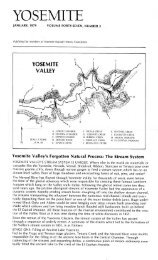
![(March 1982) [PDF] “We Are Pleased to Announce†- Yosemite Online](https://img.yumpu.com/51299748/1/190x242/march-1982-pdf-aeuroewe-are-pleased-to-announceaeur-yosemite-online.jpg?quality=85)
![[PDF] Old Horny, Yosemite's Unicorn Buck - Yosemite Online](https://img.yumpu.com/51269869/1/184x260/pdf-old-horny-yosemites-unicorn-buck-yosemite-online.jpg?quality=85)
